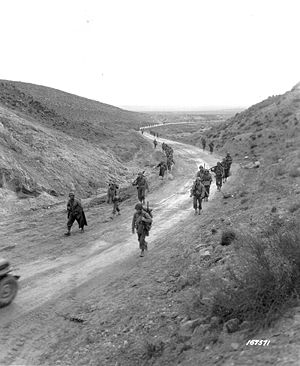| Battle of Kasserine Pass | |||||||
|---|---|---|---|---|---|---|---|
| Part of the Tunisian campaign of World War II | |||||||
 Men of the 2nd Battalion, 16th Infantry Regiment of the U.S. 1st Infantry Division march through the Kasserine Pass and on to Kasserine and Farriana, Tunisia February 26, 1943. | |||||||
| |||||||
| Belligerents | |||||||
|
|
| ||||||
| Commanders and leaders | |||||||
|
|
| ||||||
| Strength | |||||||
| 30,000[1] | 22,000[1] | ||||||
| Casualties and losses | |||||||
|
3,300 killed and wounded[2] 3,000 POWs[2] 183 tanks lost 616 vehicles lost 208 guns lost[1][3][4] (Including Sidi Bou Zid) 500 killed and wounded[5] Total: 10,000 casualties[1] |
989 killed or wounded[6] 608 captured[5] 20 tanks lost[5] 67 vehicles lost[5] 14 guns lost[5] (Including Sidi Bou Zid) | ||||||
The Battle of Kasserine Pass took place from 18-24 February 1943 at Kasserine Pass, a 2-mile-wide (3.2 km) gap in the Grand Dorsal chain of the Atlas Mountains in west central Tunisia. It was a part of the Tunisian campaign of World War II.
The Axis forces, led by Generalfeldmarschall Erwin Rommel, were primarily from the Afrika Korps Assault Group, the Italian Centauro Armored Division and two Panzer divisions detached from the 5th Panzer Army, while the Allied forces were from the U.S. II Corps (Major General Lloyd Fredendall),[7] the British 6th Armoured Division (Major-General Charles Keightley) and other parts of the First Army (Lieutenant-General Kenneth Anderson).
The battle was the first major engagement between U.S. and Axis forces in Africa. The initial handful of American battalions suffered many casualties and were successively pushed back over 50 miles (80 km) from their original positions west of Faïd Pass, until they met an advancing brigade of the U.S. 1st Armored Division.[7] British forces were also driven back, losing all eleven of their tanks in the process.[8] After the initial reversal, Allied reinforcements with strong artillery support stopped the Axis advance, and an American counterattack recaptured the mountain passes in western Tunisia, defeating the Axis offensive. The Axis force was overextended and pinned down by the Allied artillery. Facing counterattacks and airstrikes, they withdrew from the Kasserine Pass by 24 February.
Anderson was subsequently criticised by his contemporaries for, among other things, dispersing the three combat commands of the 1st Armored Division, despite the objections of the divisional commander, Major-General Orlando Ward.[9][10][11][12] As a result of lessons learned in this battle, the U.S. Army instituted sweeping changes in unit organization and tactics, and replaced some commanders[7] and some types of equipment.
- ^ a b c d Rottmann 2008, p. 74.
- ^ a b Calhoun 2015, p. 20
- ^ Heller 1986, p. 261.
- ^ "Historia de las Fuerzas Armadas alemanas. Kasserine 1943". Portal Militar y Panzertruppen (in Spanish). Columbia. Archived from the original on February 12, 2008. Retrieved January 19, 2008.
- ^ a b c d e Blumenson 1986, p. 261.
- ^ Northwest Africa - Chapter XXIV
- ^ a b c Hickman, Kennedy. "World War II: Battle of Kasserine Pass – North Africa". Militaryhistory.about.com. Archived from the original on August 16, 2016. Retrieved July 31, 2016.
- ^ Playfair et al. 2004, p. 297.
- ^ Calhoun 2015, pp. 73–75
- ^ Calhoun 2015, p. 27
- ^ Calhoun 2015, pp. 69–70
- ^ Calhoun 2015, pp. 83–85